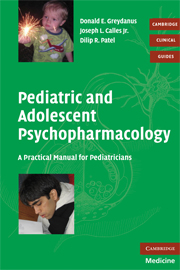Book contents
- Frontmatter
- Contents
- Contributors
- Foreword by Christopher K. Varley
- Foreword by Renée R. Jenkins
- Preface
- Acknowledgement
- 1 Principles of psychological management
- 2 The basics of pharmacology and neurotransmission
- 3 Basics of prescribing psychopharmacologic agents
- 4 Anxiety disorders
- 5 Attention deficit/hyperactivity disorder
- 6 Child and adolescent depression
- 7 Disruptive behavior and aggressive disorders
- 8 Schizophrenia in childhood and adolescence
- 9 Autism spectrum disorders
- 10 Psychotropic management of children and adolescents with cognitive–adaptive disabilities
- 11 Sleep disorders in children and adolescents
- 12 Tic disorders in children and adolescents
- 13 Substance abuse disorders
- Subject index
Preface
Published online by Cambridge University Press: 18 December 2009
- Frontmatter
- Contents
- Contributors
- Foreword by Christopher K. Varley
- Foreword by Renée R. Jenkins
- Preface
- Acknowledgement
- 1 Principles of psychological management
- 2 The basics of pharmacology and neurotransmission
- 3 Basics of prescribing psychopharmacologic agents
- 4 Anxiety disorders
- 5 Attention deficit/hyperactivity disorder
- 6 Child and adolescent depression
- 7 Disruptive behavior and aggressive disorders
- 8 Schizophrenia in childhood and adolescence
- 9 Autism spectrum disorders
- 10 Psychotropic management of children and adolescents with cognitive–adaptive disabilities
- 11 Sleep disorders in children and adolescents
- 12 Tic disorders in children and adolescents
- 13 Substance abuse disorders
- Subject index
Summary
Current research suggests that 10–20% of children, adolescents, and adults suffer from mental illness, including mood disorders, anxiety disorders, attention-deficit/hyperactivity disorder, psychotic disorders, disruptive disorders (including conduct disorder), substance abuse disorders, and others. Pediatricians and other primary care clinicians are often consulted by parents for the mental health problems of their children and adolescents.
Research has occurred mainly with adults, and thus, data on children and teenagers are very limited – though now expanding. The shortage of child and adolescent psychiatrists in the world has placed considerable strain on pediatricians and primary care practitioners in helping these children and adolescents who are taking psychopharmacologic agents. The inadequate training pediatricians often receive in behavioral pediatrics and child/adolescent psychiatry is also worsened by the limited number of available books that have been written for them.
The purpose of Pediatric and Adolescent Psychopharmacology: A Practical Manual for Pediatricians is to provide a practical resource for pediatricians, family physicians, internists, physician assistants, nurse practitioners, and various therapists caring for millions of children and youth throughout the world, who are taking a variety of psychopharmacologic agents. Many of these medication issues are controversial and most are not officially approved for use in children or adolescents. It is essential that clinicians remain up-to-date with ever changing information and prescribing patterns.
The offices of pediatricians are flooded with patients needing, requesting, and already taking a variety of these medications.
- Type
- Chapter
- Information
- Pediatric and Adolescent PsychopharmacologyA Practical Manual for Pediatricians, pp. xv - xviPublisher: Cambridge University PressPrint publication year: 2008

